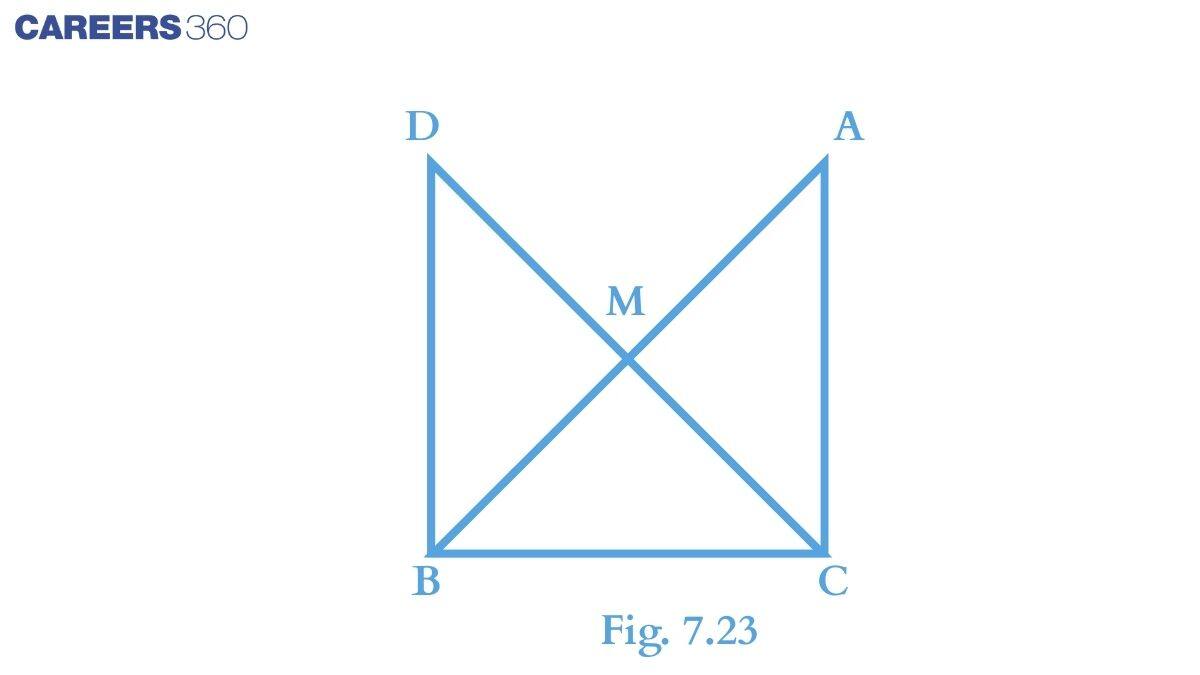NCERT Solutions for Class 9 Maths Chapter 7 Exercise 7.1 - Triangles
A closed figure that is formed by intersecting three lines is called a triangle. A triangle has three sides, three vertices and three angles. A triangle is denoted by the symbol $∆$, and an angle is denoted by the symbol $∠$. Suppose a triangle PQR is given; then it is denoted by ∆PQR, and the angles are denoted by ∠P, ∠Q, and ∠R. A triangle has many properties, and one of them is congruence. Two triangles are said to be congruent if the corresponding sides and angles are equal. Two triangles are congruent based on some criteria: SAS, ASA, AAS, SSS, and RHS.
This Story also Contains
- Access Triangles Class 9 Chapter 7 Exercise: 7.1
- Topics Covered in Chapter 7 Triangles: Exercise 7.1
- NCERT Solutions of Class 9 Subject Wise
- Subject-Wise NCERT Exemplar Solutions

In this chapter, we'll explore the basic concept of triangles, one of the basic shapes in geometry. This class 9 maths chapter 7 exercise 7.1 helps you understand the properties of triangles and how to work with them. Our easy-to-follow NCERT Solutions provide step-by-step explanations, and you can also download the free PDF version for offline use. Let's get started and learn about triangles together. Along with the NCERT book of Class 9 Maths, chapter 7, exercise 7.1, the following exercises are also present.
Access Triangles Class 9 Chapter 7 Exercise: 7.1
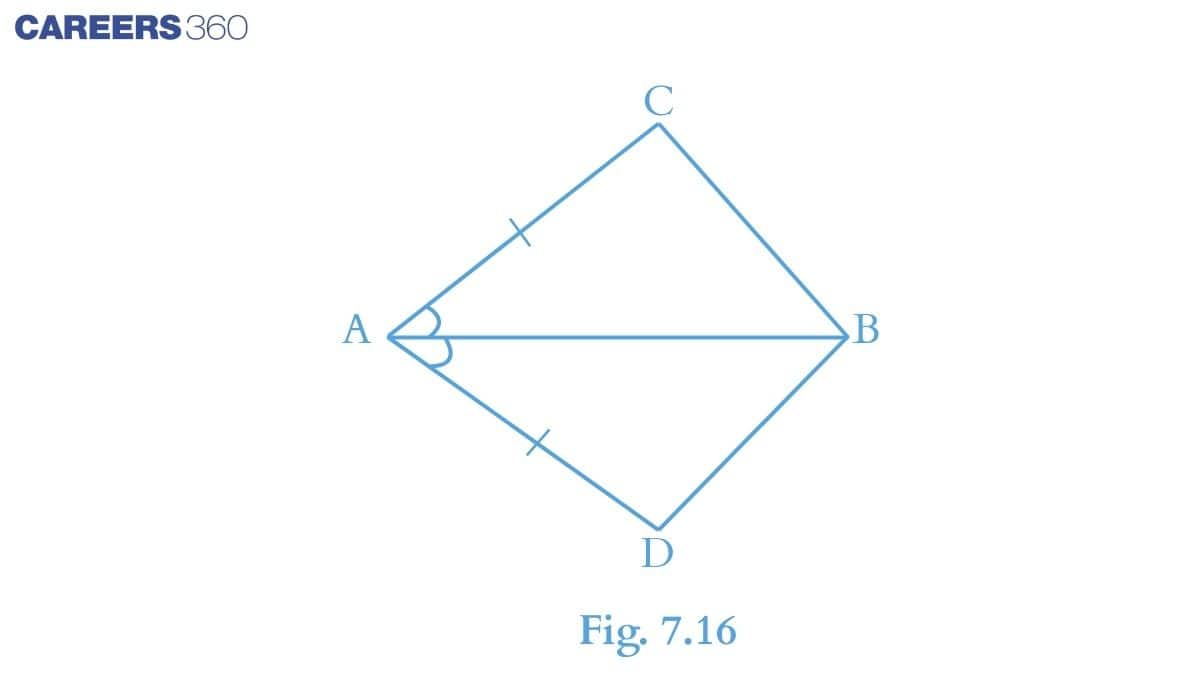
Solution:
In the given triangles, we are given that:-
In $\small \Delta ABC$ and $\small \Delta ABD$
(i) $\small AC=AD$
(ii) Further, it is given that AB bisects angle A.
Thus, $\angle$ BAC $=\ \angle$ BAD.
(iii) Side AB is common to both triangles. $AB=AB$
Hence by SAS congruence, we can say that: $\small \Delta ABC\cong \Delta ABD$
By C.P.C.T. (corresponding parts of congruent triangles are equal) we can say that $BC\ =\ BD$
Q2 (i) $ABCD$ is a quadrilateral in which $\small AD=BC$ and $\small \angle DAB= \angle CBA$ (see Fig. 7.17). Prove that $\small \Delta ABD\cong \Delta BAC$ .
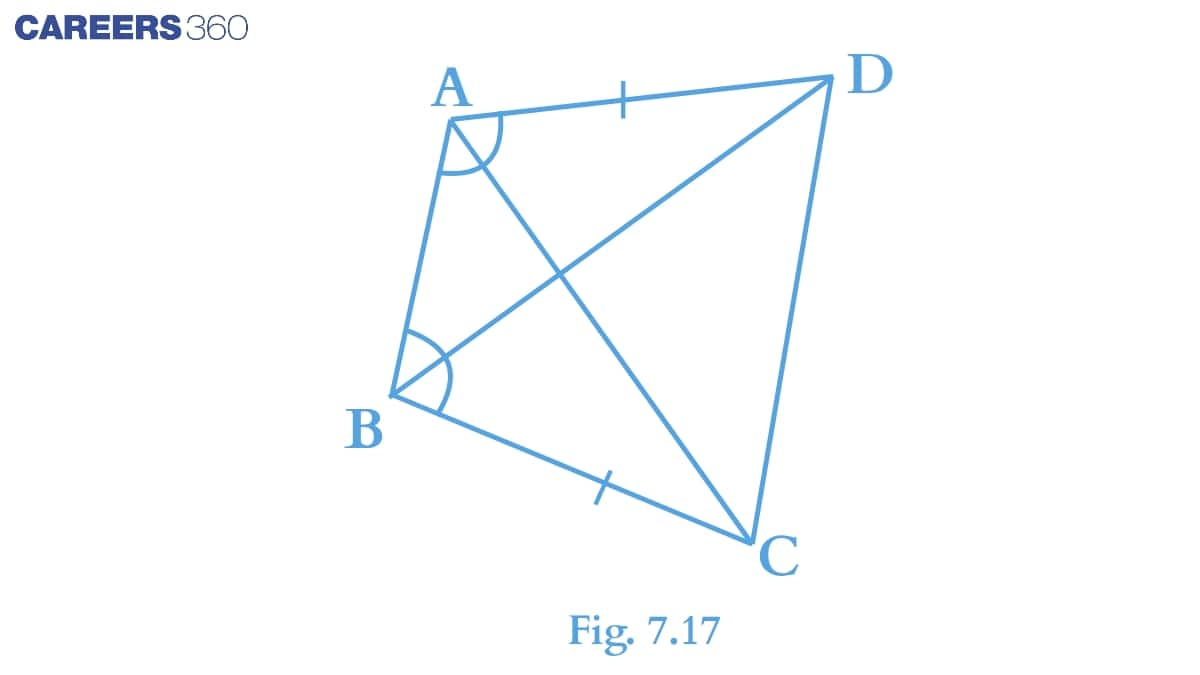
Solution:
In $\small \Delta ABD$ and $\Delta BAC$
(i) AD = BC
(ii) $\small \angle DAB= \angle CBA$
(iii) AB = AB (Side AB is common to both the triangles)
So, by SAS congruence, we can write :
$\small \Delta ABD\cong \Delta BAC$
Q2 (ii) ABC $\small ABCD$ is a quadrilateral in which $\small AD=BC$ and $\small \angle DAB=\angle CBA$ (see Fig.7.17). Prove that $\small BD=AC$
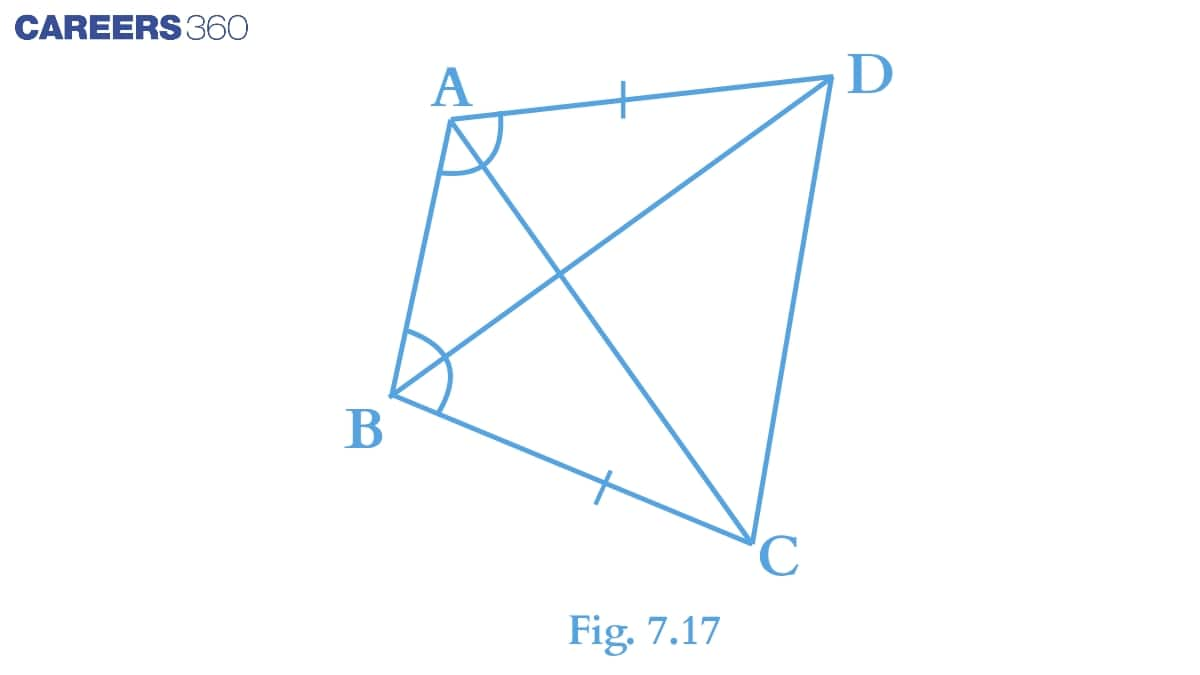
Solution:
In the previous part, we have proved that $\small \Delta ABD\cong \Delta BAC$.
Thus, by C.P.C.T., we can write: $\small BD=AC$
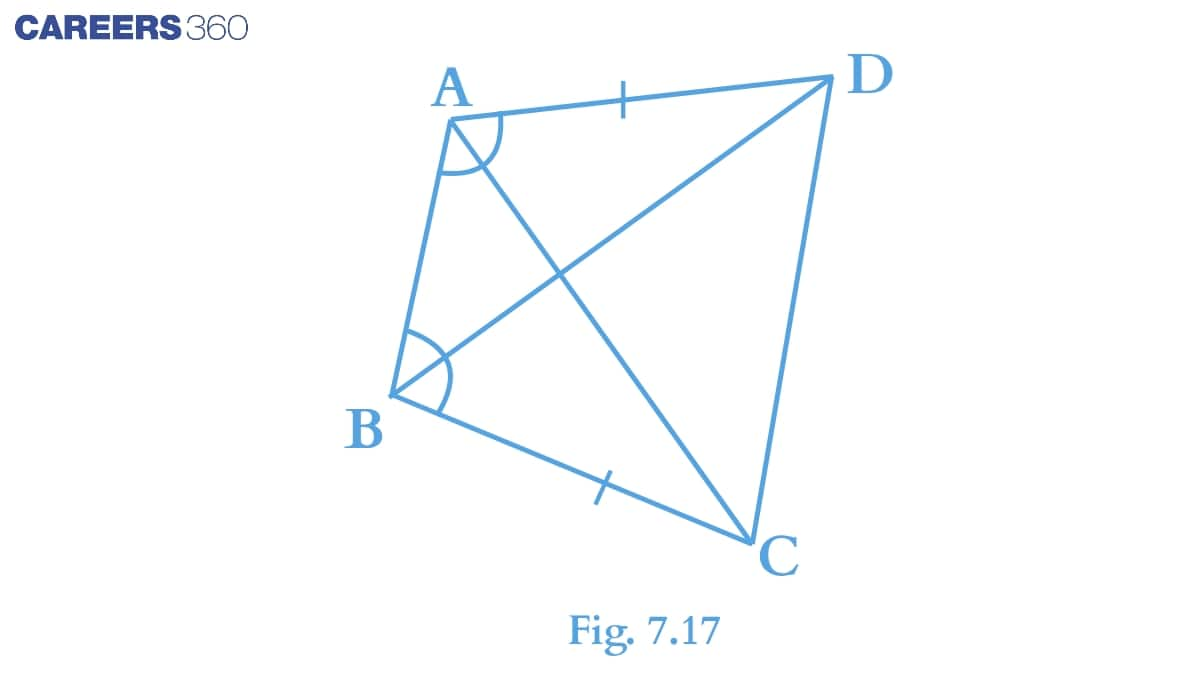
Solution:
In the first part we have proved that $\small \Delta ABD\cong \Delta BAC$.
Thus, by C.P.C.T., we can conclude,
$\small \angle ABD= \angle BAC$ ∠ABD=∠B
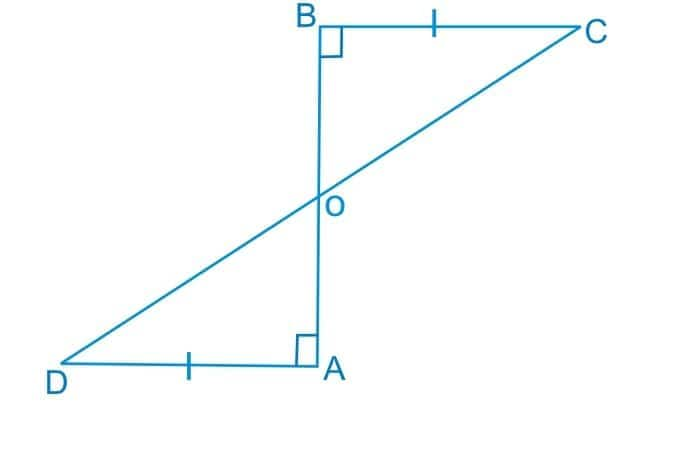
Solution:
In the given figure consider $\Delta$ AOD and $\Delta$ BOC.
(i) AD = BC (Given)
(ii) $\angle$ A = $\angle$ B (Given that the line AB is perpendicular to AD and BC)
(iii) $\angle$ AOD = $\angle$ BOC (Vertically opposite angles).
Thus by AAS Postulate, we have
$\Delta AOD\ \cong \ \Delta BOC$
Hence, by C.P.C.T. we can write: $AO\ =\ OB$
Thus, CD bisects AB.
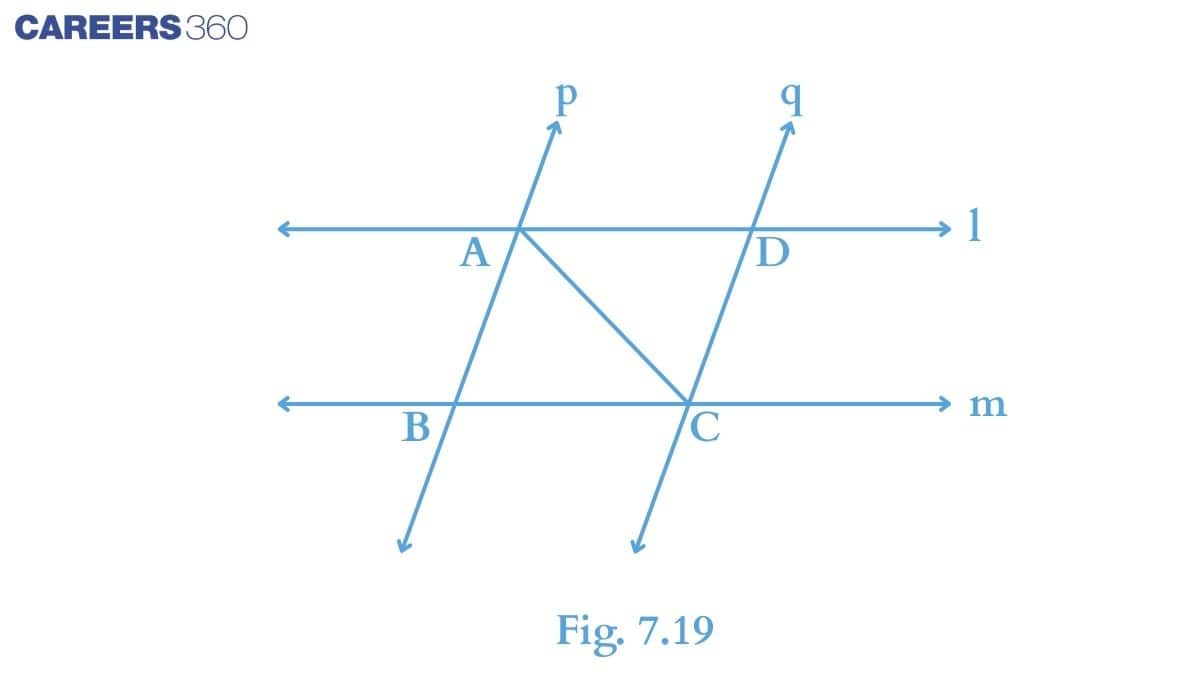
Solution:
In the given figure, consider $\Delta$ ABC and $\Delta$ CDA :
(i) $\angle\ BCA\ =\ \angle DAC$ (Alternate interior angles)
(ii) $\angle\ BAC\ =\ \angle DCA$ (Alternate interior angles)
(iii) Side AC is common in both the triangles.
Thus by ASA congruence, we have:
$\Delta ABC\ \cong \ \Delta CDA$
ΔABC ≅ ΔCD
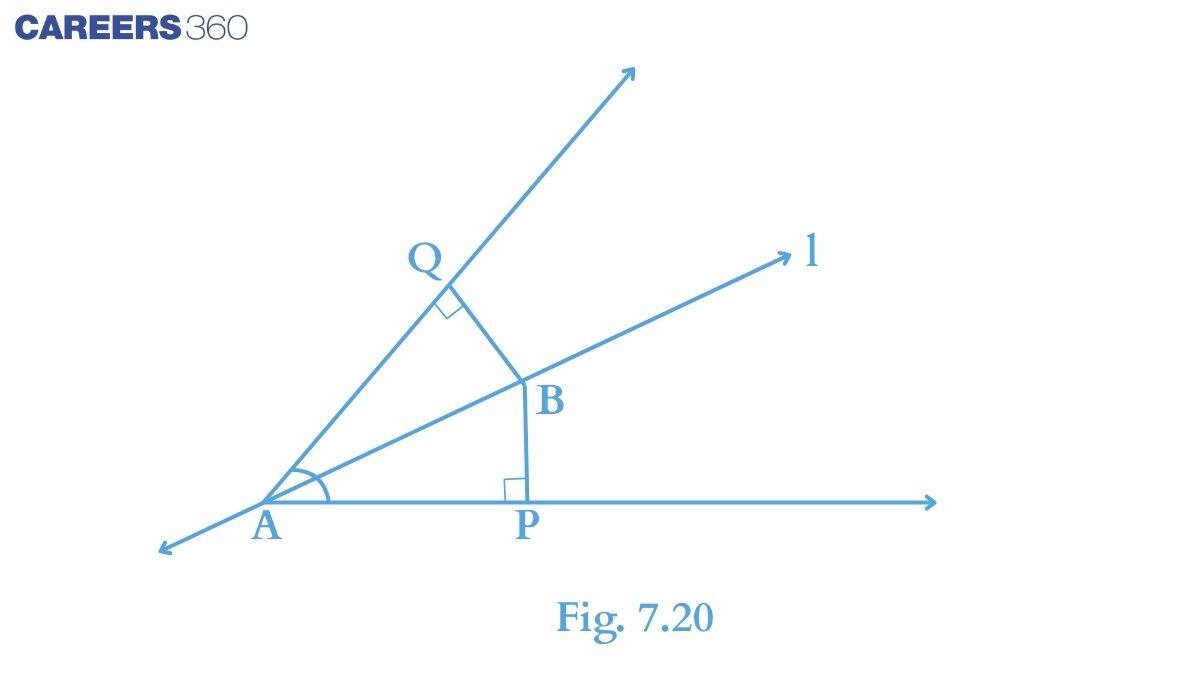
Solution:
In the given figure consider $\small \Delta APB$ and $\small \Delta AQB$,
(i) $\angle P\ =\ \angle Q$ (Right angle)
(ii) $\angle BAP\ =\ \angle BAQ$ (Since it is given that I is bisector)
(iii) Side AB is common to both triangles.
Thus, AAS congruence, we can write:
$\small \Delta APB\cong \Delta AQB$
ΔAPB≅ΔAQ
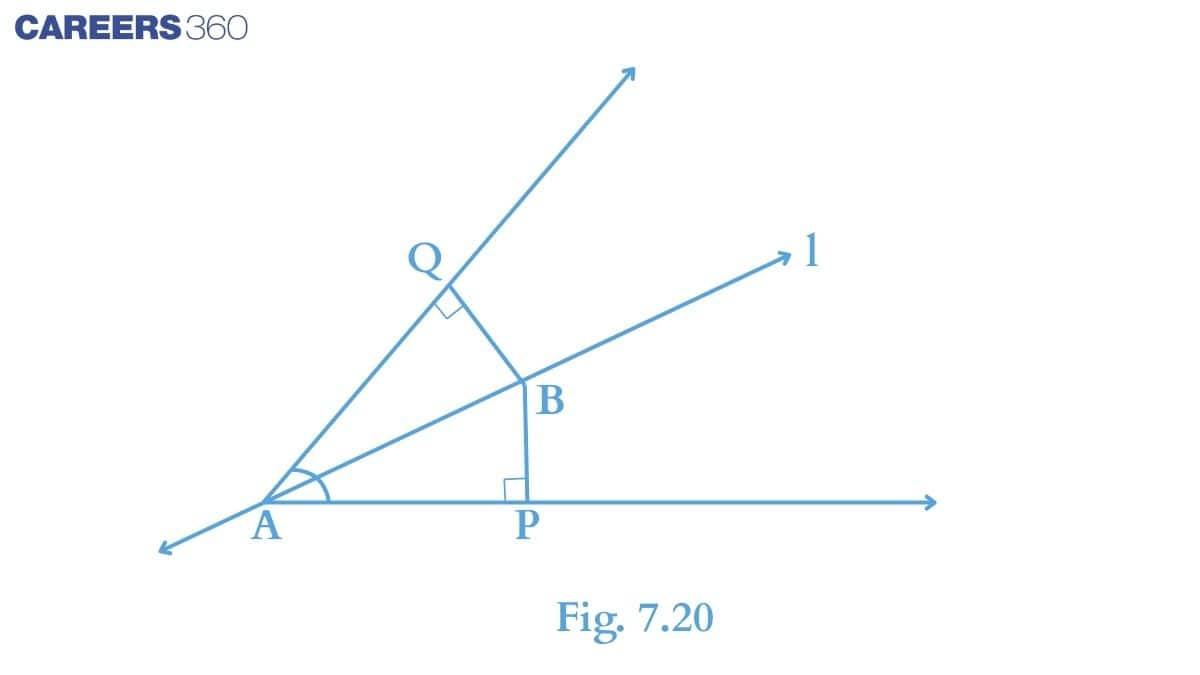
Solution:
In the previous part, we have proved that $\small \Delta APB\cong \Delta AQB$.
Thus, by C.P.C.T., we can write:
$BP\ =\ BQ$
Thus, B is equidistant from the arms of angle A.
Q6. In Fig, $\small AC=AE,AB=AD$ and $\small \angle BAD= \angle EAC$ . Show that $\small BC=DE$ .
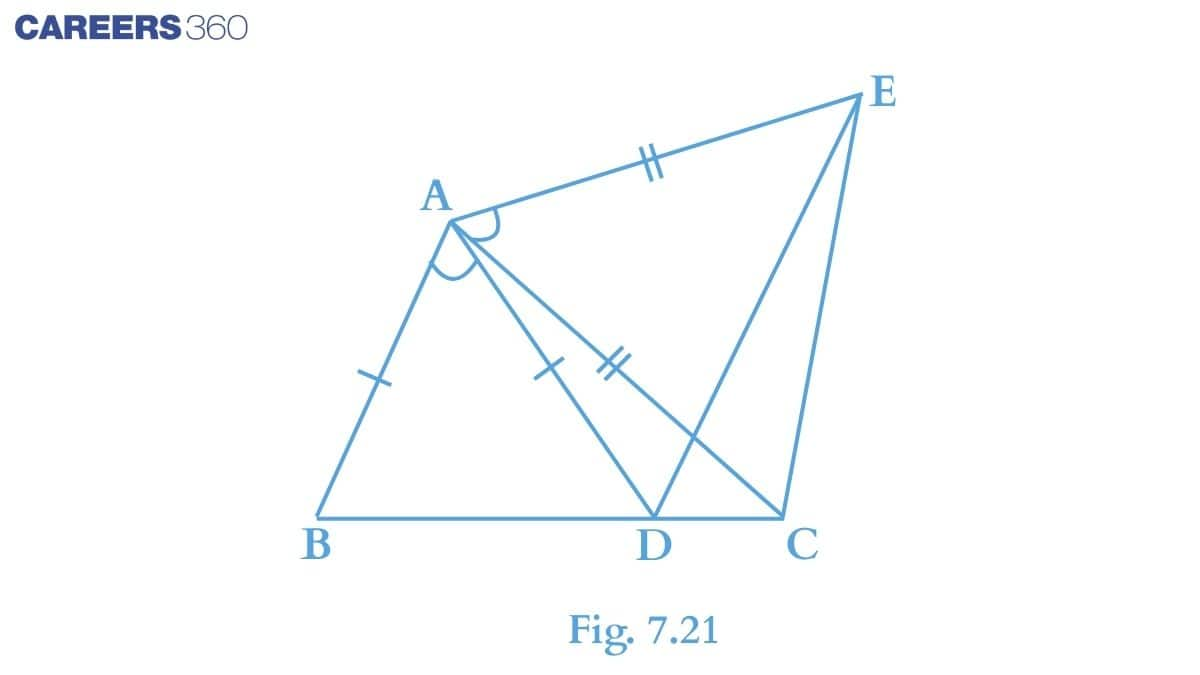
Solution:
From the given figure following result can be drawn:-
$\angle BAD\ =\ \angle EAC$
Adding $\angle DAC$ to both sides, we get:
$\angle BAD\ +\ \angle DAC\ =\ \angle EAC\ +\ \angle DAC$
$\angle BAC\ =\ \angle EAD$
Now consider $\Delta ABC$ and $\Delta ADE$ , :-
(i) $AC\ =\ AE$ (Given)
(ii) $\angle BAC\ =\ \angle EAD$ (Proved above)
(iii) $AB\ =\ AD$ (Given)
Thus, by SAS congruence, we can say that :
$\Delta ABC\ \cong \ \Delta ADE$
Hence by C.P.C.T., we can say that : $BC\ =\ DE$
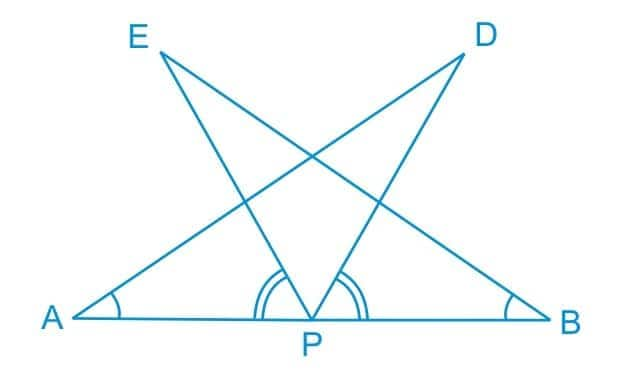
Solution:
From the figure, it is clear that :
$\angle EPA\ =\ \angle DPB$
Adding $\angle DPE$ both sides, we get:
$\angle EPA\ +\ \angle DPE =\ \angle DPB\ +\ \angle DPE$
Or $\angle DPA =\ \angle EPB$
Now, consider $\Delta DAP$ and $\Delta EBP$ :
(i) $\angle DPA =\ \angle EPB$ (Proved above)
(ii) $AP\ =\ BP$ (Since P is the midpoint of line AB)
(iii) $\small \angle BAD=\angle ABE$ (Given)
Hence, by ASA congruence, we can say that:
$\small \Delta DAP\cong \Delta EBP$
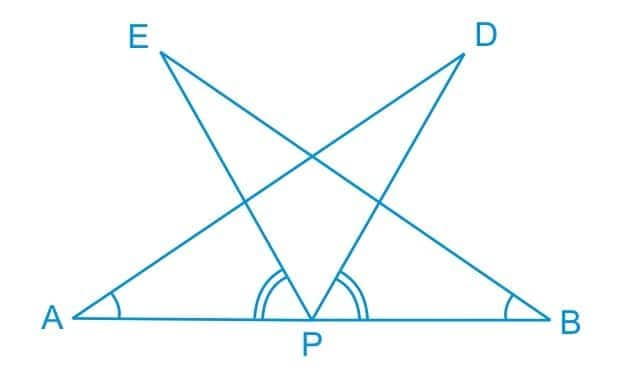
Solution:
In the previous part we have proved that $\small \Delta DAP\cong \Delta EBP$.
Thus, by C.P.C.T., we can say that:
$\small AD=BE$
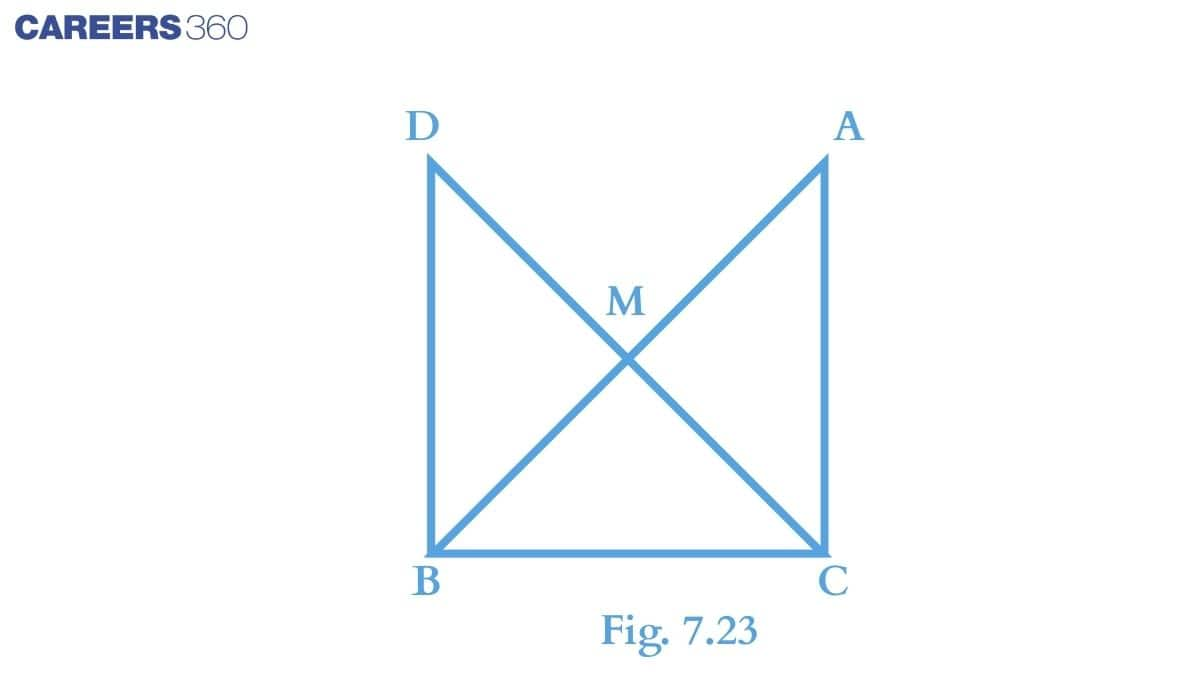
Solution:Consider $\Delta AMC$ and $\Delta BMD$,
(i) $AM\ =\ BM$ (Since M is the mid-point)
(ii) $\angle CMA\ =\ \angle DMB$ (Vertically opposite angles are equal)
(iii) $CM\ =\ DM$ (Given)
Thus, by SAS congruency, we can conclude that:
$\small \Delta AMC\cong \Delta BMD$
Solution:
In the previous part, we have proved that $\small \Delta AMC\cong \Delta BMD$.
By c.p.c.t. we can say that: $\angle ACM\ =\ \angle BDM$
This implies side AC is parallel to BD.
Thus, we can write : $\angle ACB\ +\ \angle DBC\ =\ 180^{\circ}$ (Co-interior angles)
And, $90^{\circ}\ +\ \angle DBC\ =\ 180^{\circ}$
Or $\angle DBC\ =\ 90^{\circ}$
Hence, $\small \angle DBC$ is a right angle.
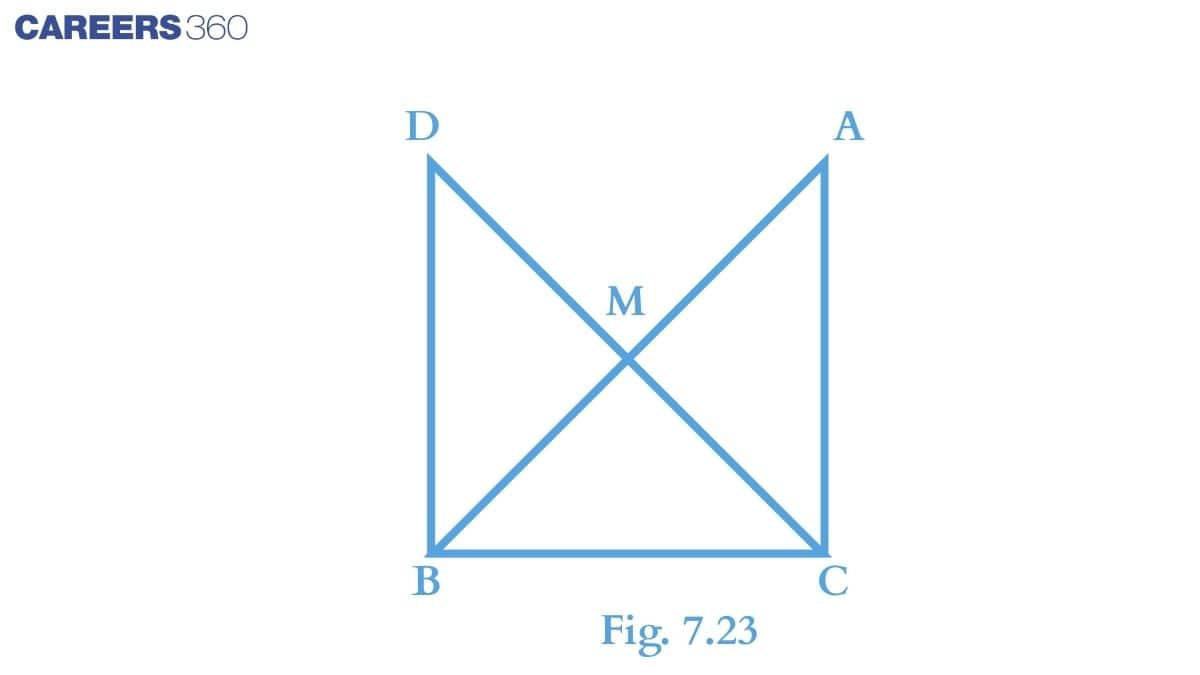
Solution:Consider $\Delta DBC$ and $\Delta ACB$,
(i) $BC\ =\ BC$ (Common in both the triangles)
(ii) $\angle ACB\ =\ \angle DBC$ (Right angle)
(iii) $DB\ =\ AC$ (By c.p.c.t. from part (a) of the question.)
Thus, SAS congruence we can conclude that:
$\small \Delta DBC\cong \Delta ACB$
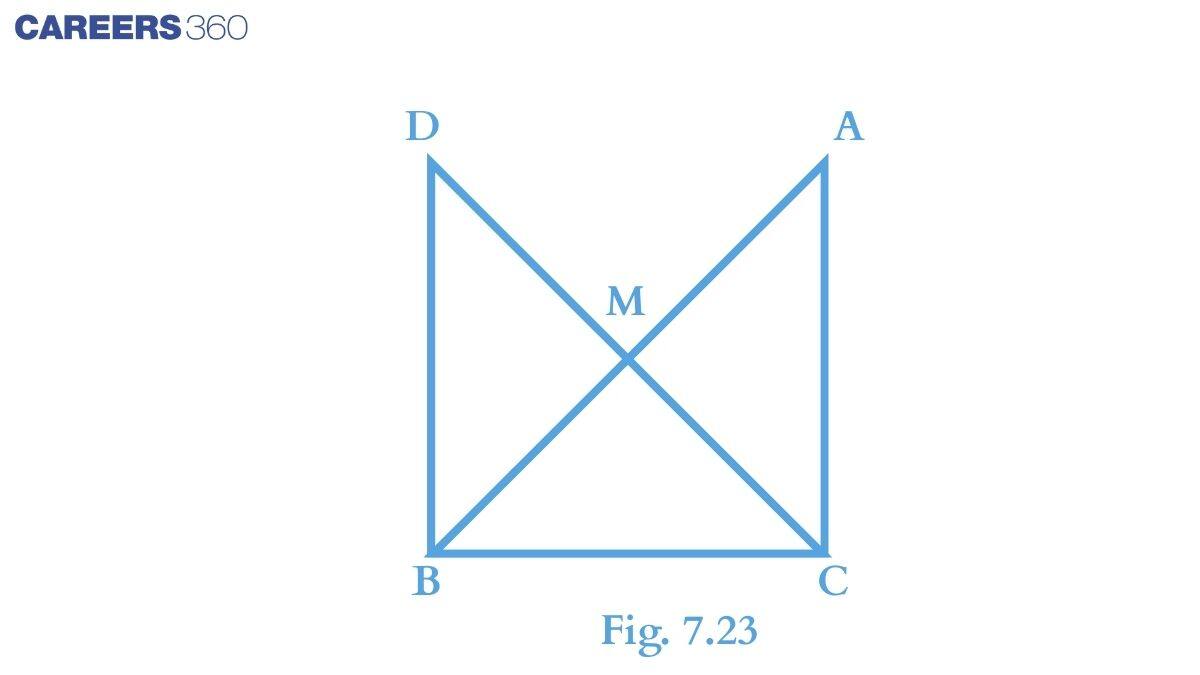
Solution:
In the previous part, we have proved that
$\Delta DBC\ \cong \ \Delta ACB$.
Thus by c.p.c.t., we can write : $DC\ =\ AB$
$DM\ +\ CM\ =\ AM\ +\ BM$
Or $CM\ +\ CM\ =\ AB$ (Since M is the midpoint.)
Or $\small CM=\frac{1}{2}AB$.
Hence proved.
Topics Covered in Chapter 7 Triangles: Exercise 7.1
- From NCERT solutions for Class 9 Maths chapter 7 exercise 7.1, we get to learn that the SAS Criteria for Congruence triangles are congruent if their two sides and included angle are the same as the corresponding sides and included angle of the other triangle.
- ASA Criteria for Congruence - Two triangles are congruent if their two angles and included sides are equal to the other triangle's corresponding two angles and included sides.
- AAS criteria for Congruence - Two triangles are said to be congruent if two angles and one side of one triangle are equal to two angles and one side of the other triangle.
Also See
NCERT Solutions of Class 9 Subject Wise
Students must check the NCERT solutions for Class 9 Maths and Science given below:
Subject-Wise NCERT Exemplar Solutions
Students must check the NCERT exemplar solutions for Class 9 Maths and Science given below:
Frequently Asked Questions (FAQs)
This exercise is about TRIANGLES, congruence of triangles and different methods of congruency.
A triangle is a closed geometric object with three sides and three angles that has three sides and three angles.
A maximum of one right angle is possible in a triangle, if it exceeds one it will nullify the criteria for triangle formation.
Side-Side-Side Criterion, Side-Angle-Side Criterion, Angle-Side-Angle Criterion, right angle-hypotenuse-side congruence.
Angle-Side-Angle is also called ASA criterion states that:
If two angles and the side which is included between them are equal for two triangles then the triangles are congruent.
When two lines intersect each other at a point, then the opposite angles formed due to this intersection are called vertically opposite angles. They are always equal to each other.
The angles are 30°, 60° and 90°
Courses After 12th
Applications for Admissions are open.
As per latest syllabus. Physics formulas, equations, & laws of class 11 & 12th chapters
JEE Main Important Chemistry formulas
Get nowAs per latest syllabus. Chemistry formulas, equations, & laws of class 11 & 12th chapters
JEE Main high scoring chapters and topics
Get nowAs per latest 2024 syllabus. Study 40% syllabus and score upto 100% marks in JEE
JEE Main Important Mathematics Formulas
Get nowAs per latest syllabus. Maths formulas, equations, & theorems of class 11 & 12th chapters
